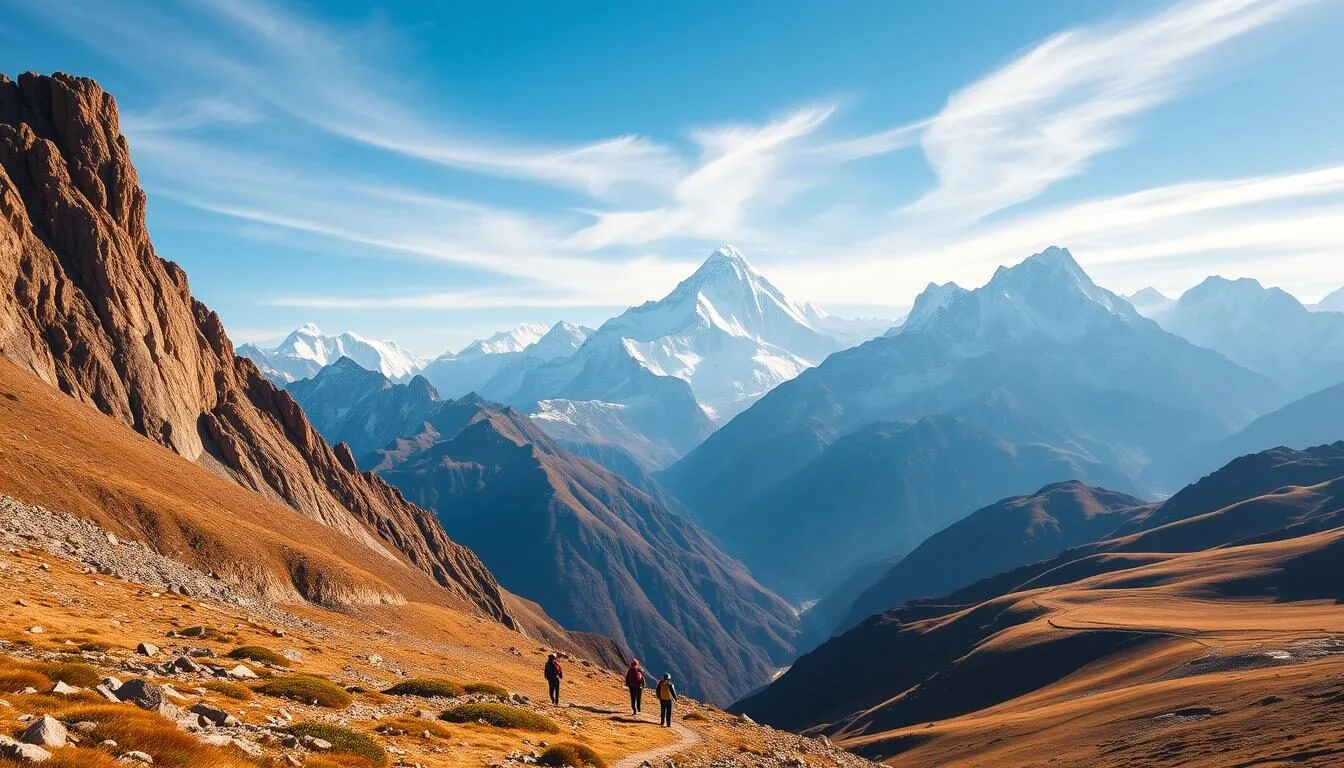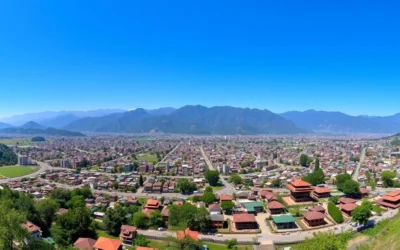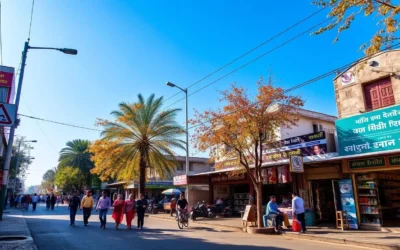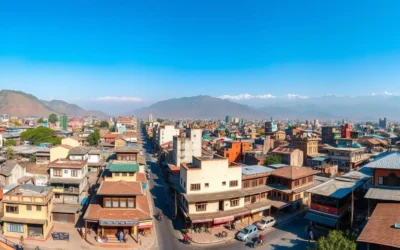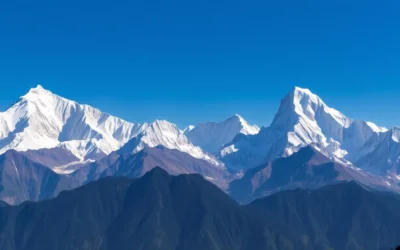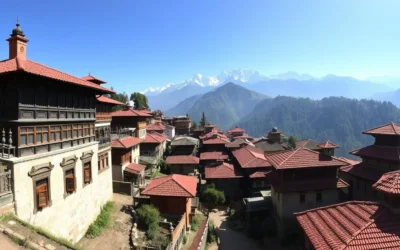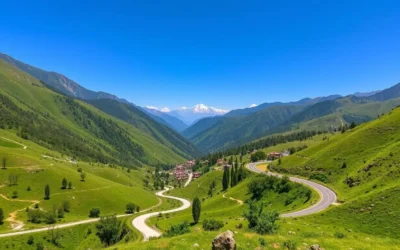✓ Accommodations✓ Flights✓ Rental Cars
Imagine standing at an altitude of 17,598 feet, surrounded by the majestic Himalayas. Every year, thousands of trekkers from around the world embark on the journey to Everest Base Camp, making it one of the most rewarding trekking experiences globally.
As you trek through Sherpa villages and monasteries, the journey becomes as significant as the destination. The trail offers breathtaking landscapes, making every day of your trip a new experience. Proper preparation and knowledge can make your journey more enjoyable and successful.
This article will guide you through planning tips, the best time to visit, and top activities along the trail to base camp, ensuring you’re well-prepared for an unforgettable adventure.
The Majestic Everest Base Camp: An Overview
Located in the Khumbu region of Nepal, Everest Base Camp is the ultimate destination for adventure seekers and mountaineers alike. As the endpoint of the legendary Everest trek, it attracts visitors from around the world.
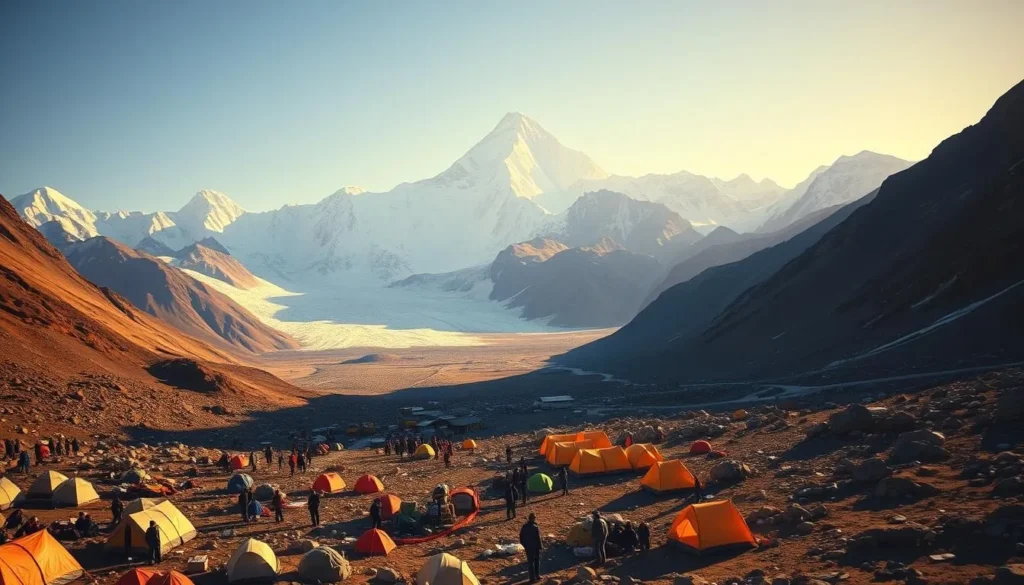
Where is Everest Base Camp Located?
Everest Base Camp is situated at the end of a long valley in the Himalayas, near the Sherpa village of Dingboche. The camp is nestled in the Solu-Khumbu district of Nepal, within the Sagarmatha National Park, a UNESCO World Heritage Site. The region is renowned for its breathtaking landscapes and rich cultural heritage.
- The Everest Base Camp is located in the Khumbu region of Nepal.
- It’s the South Base Camp that most trekkers visit, as opposed to the North Base Camp in Tibet.
- The camp is at an altitude of 17,598 feet (5,364 meters), making it a challenging yet rewarding destination.
The Significance of Everest Base Camp
The Base Camp serves as the starting point for mountaineers attempting to summit Mount Everest. It’s also a destination in its own right, offering trekkers a chance to experience the majesty of the Himalayas up close. The camp’s proximity to the Khumbu Icefall, the first major obstacle for climbers, underscores its significance in the mountaineering world.
The Everest Base has become a cultural and historical landmark, symbolizing the human spirit of adventure and exploration. As you trek to the camp, you’re not just heading to a geographical location; you’re immersing yourself in the rich Sherpa culture and the natural beauty of the region.
History of Everest Base Camp
As you embark on the journey to Everest Base Camp, understanding its rich history adds depth to your experience. The story of Everest Base Camp is deeply intertwined with the history of mountaineering on Mount Everest.
Early Expeditions and Establishment
The early 20th century marked the beginning of serious attempts to climb Mount Everest. In the 1920s, a team led by George Mallory attempted to map the north face, although they didn’t establish a permanent base camp. The north route was later closed off when China invaded Tibet in 1949, shifting focus to the south side in Nepal. The successful 1953 expedition by Edmund Hillary and Tenzing Norgay highlighted the need for a permanent Everest Base Camp on the south side.
![]()
Hillary and Norgay’s achievement not only marked a historic milestone but also underscored the practical value of having a supply storage location at the base camp. This realization paved the way for the establishment of a permanent camp, which would later become a crucial part of mountaineering infrastructure.
Evolution into a Trekking Destination
Over time, Everest Base Camp evolved from a purely functional mountaineering site to a popular destination for trekkers. As the mountain drew more adventurers, the camp became a hub for people from around the world. The infrastructure developed to support climbers and trekkers alike, transforming the area into a vibrant community. Today, Everest Base is not just a staging point for climbers but a destination in its own right, attracting people from all walks of life.
The evolution was also influenced by political changes, such as China’s invasion of Tibet, which redirected access to Everest Base Camp through Nepal. This shift contributed to the prominence of the Nepal-side base camp, making it a focal point for both climbers and trekkers.
Planning Your Everest Base Camp Trek
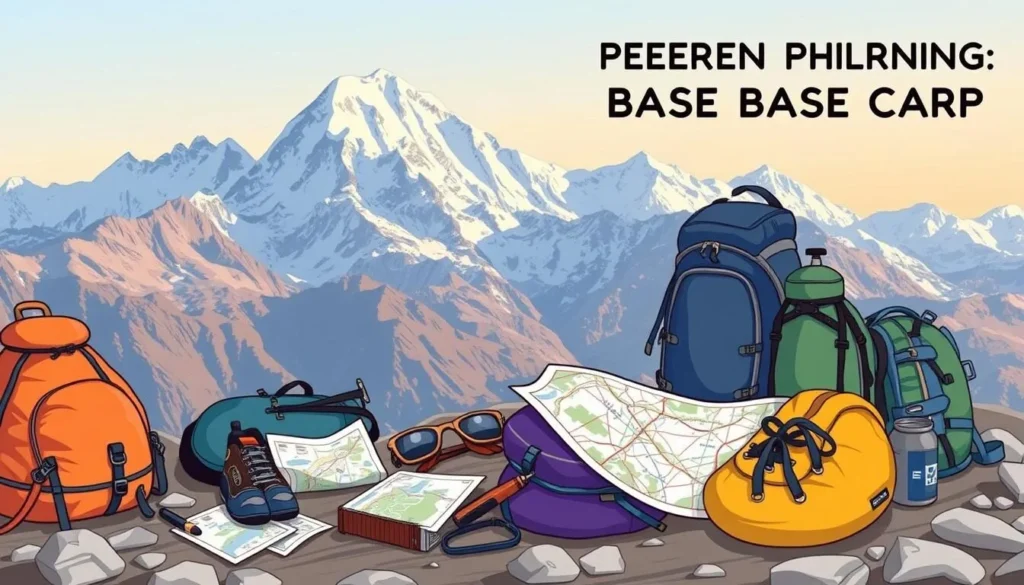
As you prepare for your Everest Base Camp trek, it’s essential to understand the trek’s duration, distance, and cost considerations. The Everest Base Camp trek is a significant undertaking that requires careful planning to ensure a successful and enjoyable experience.
Trek Duration and Distance
The complete Everest Base Camp trek typically requires 12-14 days to cover the 80-mile (130km) roundtrip from Lukla to Everest Base Camp and back. Your daily walking distances will typically range from 8-10 miles per day, with hiking times usually up to 8 hours daily.
It’s also important to note that “rest days” on the trek are actually acclimatization days that still involve some walking to help your body adjust to the altitude. This careful pacing is crucial to avoiding altitude sickness and ensuring a safe and enjoyable journey.
Cost Considerations
All-inclusive tour packages for the Everest Base Camp trek typically start around $4,295 USD, but costs can vary widely depending on the trekking company and services included. When planning your trip, consider what’s usually included in trek packages, such as guides, porters, accommodation, and meals, versus what additional expenses you should budget for.
Choosing a reputable trekking company with experienced guides is crucial for safety and enjoyment. To prepare physically and mentally for the trek, consider training beforehand and familiarizing yourself with the trek’s demands to ensure the best possible experience.
By understanding the trek’s duration, distance, and cost considerations, you can better prepare yourself for the adventure of a lifetime. With careful planning and the right guidance, your Everest Base Camp trek is sure to be an unforgettable experience.
Best Time to Visit Everest Base Camp
The ideal time for visiting Everest Base Camp is influenced by weather conditions and personal trekking preferences. The trek can be undertaken throughout the year, but certain periods offer more favorable conditions than others.
Spring Season (March-May)
The spring season, from late March to May, is one of the best times to trek to Everest Base Camp. During these months, the weather is generally mild, and the clear skies offer stunning views of the Himalayas. The rhododendron forests are also in bloom, adding vibrant colors to the landscape. April is particularly popular due to the comfortable temperatures and clear skies, although it attracts larger crowds.
Autumn Season (September-November)
The autumn season, spanning from late September to November, is another peak trekking period. The monsoon rains have subsided by this time, leaving the trails relatively dry and the skies clear. The temperatures are cool, making the trek comfortable, and the views of the mountains are breathtaking. October is a favorite among trekkers for its stable weather conditions, but like April, it also means busier trails.
Winter and Monsoon Seasons
Trekking during the winter months (December-February) is challenging due to extreme cold and potential snow blockages on the trails. However, the scenery is serene, and the crowds are smaller. The monsoon season (June-September) brings heavy rainfall, making the trails slippery and prone to landslides, with leeches and other challenges common. While these seasons have their drawbacks, they also offer unique experiences for trekkers who are well-prepared.
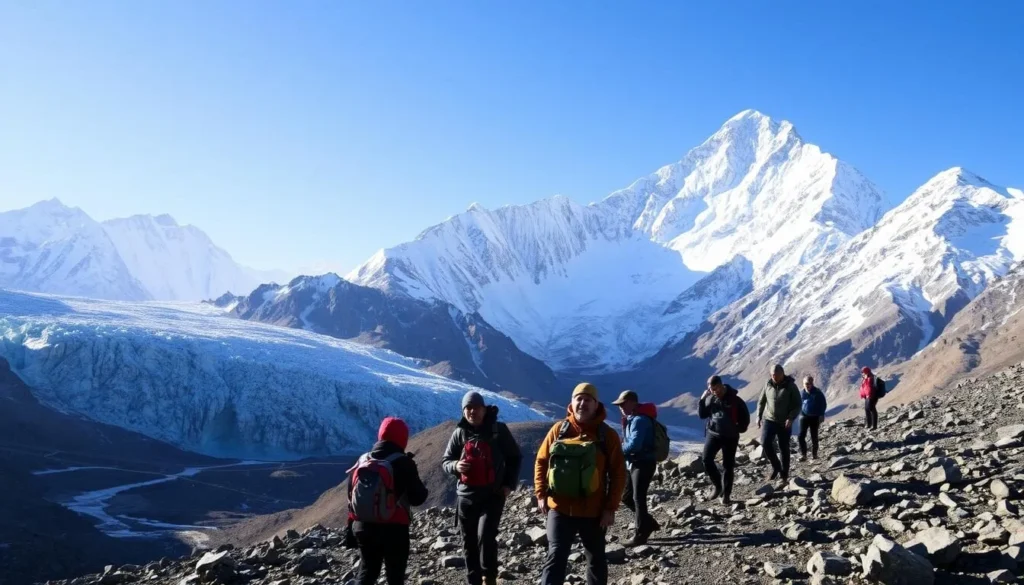
When choosing the best time for your trek to Everest Base Camp, consider your preferences regarding weather, crowd sizes, and specific experiences like witnessing the rhododendrons in bloom. The weather and conditions vary significantly at different elevations throughout the year, so it’s essential to be prepared for the conditions you’ll encounter during your chosen months of travel.
Trek to Namche Bazaar: Gateway to Everest
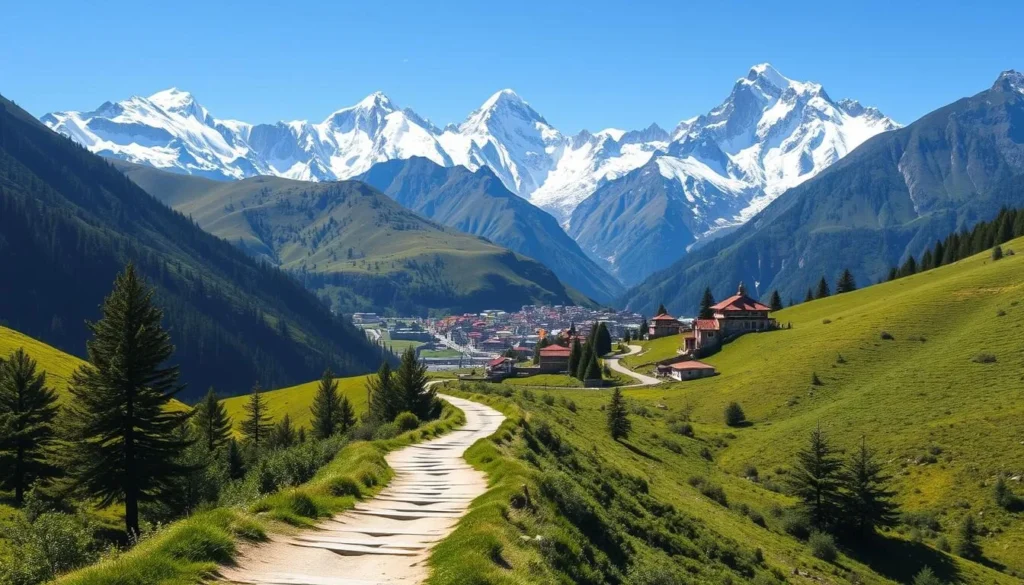
Your trek to Everest Base Camp begins with a thrilling flight to Lukla, followed by a scenic trail to Namche Bazaar, the gateway to the Everest region.
The Thrilling Flight to Lukla
The morning flight to Lukla’s Tenzing-Hillary Airport is an exhilarating experience, offering breathtaking views of the Himalayan foothills. The short 25-minute flight on small propeller planes, such as Dornier Do228s or Twin Otters, is an adventure in itself. The landing at Lukla is particularly notable due to the airport’s challenging runway, with one end being 60m (197ft) higher than the other, making it one of the world’s most exciting landings.
Exploring Namche Bazaar
After arriving in Lukla, the trek to Namche Bazaar takes you through a scenic trail, crossing suspension bridges and gradually ascending into the Khumbu region. Namche Bazaar is not only the largest Sherpa settlement in the area but also a crucial acclimatization stop. Trekkers typically spend two nights here to adjust to the altitude. The town offers various amenities, including equipment shops, restaurants, bakeries, and the famous Saturday market. During your acclimatization day, you can visit the Sagarmatha National Park Museum or hike to nearby viewpoints.
The journey to Namche Bazaar is a significant part of your trek to Everest Base Camp, setting the stage for the adventures that lie ahead on your route to the base camp.
Visit Sagarmatha National Park Museum
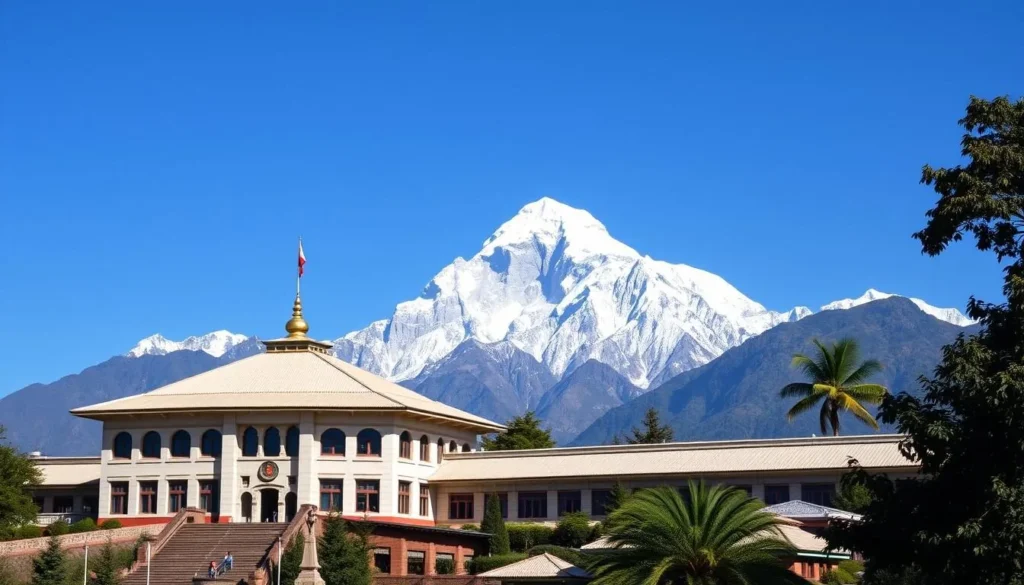
During your acclimatization day in Namche Bazaar, the Sagarmatha National Park Museum is an essential stop to explore the rich culture of the Khumbu Sherpa people. This museum is perched above the village, offering breathtaking views of Everest and Nuptse.
Exhibits and Cultural Significance
The Sagarmatha National Park Museum is a treasure trove of information on the local flora, fauna, geology, and mountaineering history in the Everest region. The exhibits provide valuable insights into the unique culture and traditions of the Khumbu Sherpa people, enhancing your understanding of the region’s cultural significance. By learning about conservation efforts in the Sagarmatha National Park, you can appreciate the importance of preserving this fragile ecosystem.
Spectacular Views from the Museum
The forecourt of the museum offers spectacular panoramic views of Mount Everest and Nuptse, providing your first clear glimpse of these majestic mountains. The best time to visit is early morning or late afternoon for optimal views and photography opportunities. This visit also aids in acclimatization by following the “climb high, sleep low” principle, making it a beneficial stop on your trek to Everest Base Camp.
By visiting the Sagarmatha National Park Museum, you not only gain a deeper understanding of the local culture and history but also enjoy stunning views of the mountain landscape. This experience will enrich your trekking journey, providing context for the cultural and natural wonders you’ll encounter throughout your adventure to Everest Base Camp and Namche Bazaar.
Experience Tengboche Monastery
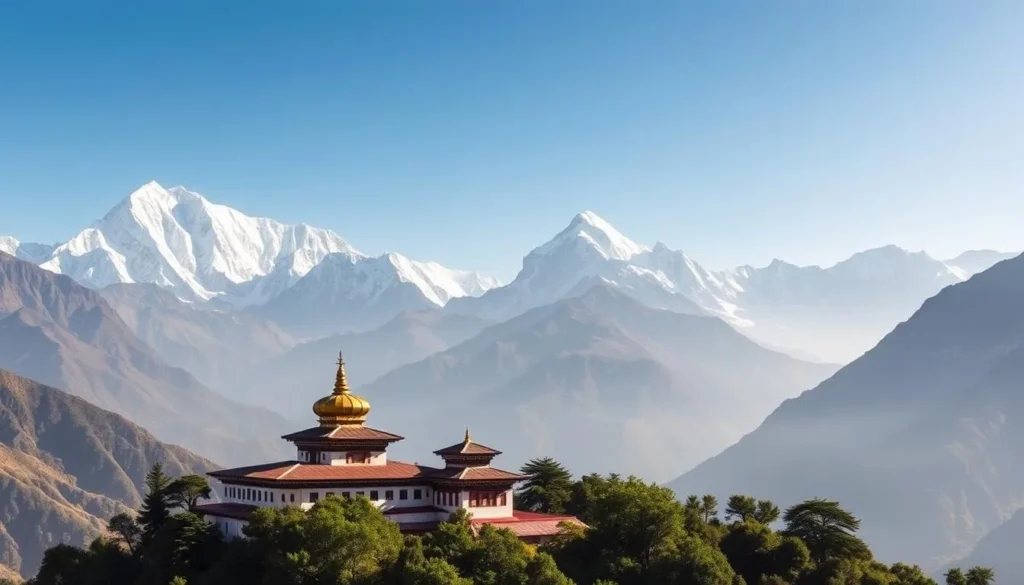
On your trek to Everest Base Camp, Tengboche Monastery stands out as a beacon of Buddhist culture and tradition. This significant spiritual center is a must-visit for trekkers and climbers seeking blessings before continuing their journey.
Buddhist Culture and Traditions
Tengboche Monastery, also known as Thyangboche Monastery or Dawa Choling Gompa, is the largest Buddhist monastery in the Everest valley. The monastery’s beautiful architecture and interior, adorned with colorful paintings, statues, and religious artifacts, reflect the rich Sherpa culture. You can witness the daily life of monks and participate in Buddhist ceremonies and prayer sessions, gaining a deeper understanding of the local traditions.
The monastery’s historical importance in the region is evident in its role in preserving Sherpa Buddhist culture. By visiting Tengboche Monastery, you contribute to the preservation of this cultural heritage.
Panoramic Mountain Views
The monastery grounds offer breathtaking panoramic views of the surrounding mountains, including Everest, Lhotse, Nuptse, and the iconic Ama Dablam. The serene atmosphere provides a welcome contrast to the physical challenges of the trek to Everest Base Camp. You can enjoy the peaceful ambiance and take in the stunning views, making your trekking experience even more memorable.
Participating in the morning or evening prayer ceremonies can enhance your cultural experience. The monastery’s peaceful atmosphere and the opportunity to witness or participate in religious ceremonies make it a unique and enriching stop on your trail to Everest Base Camp.
Hike to Kala Patthar for Sunrise Views
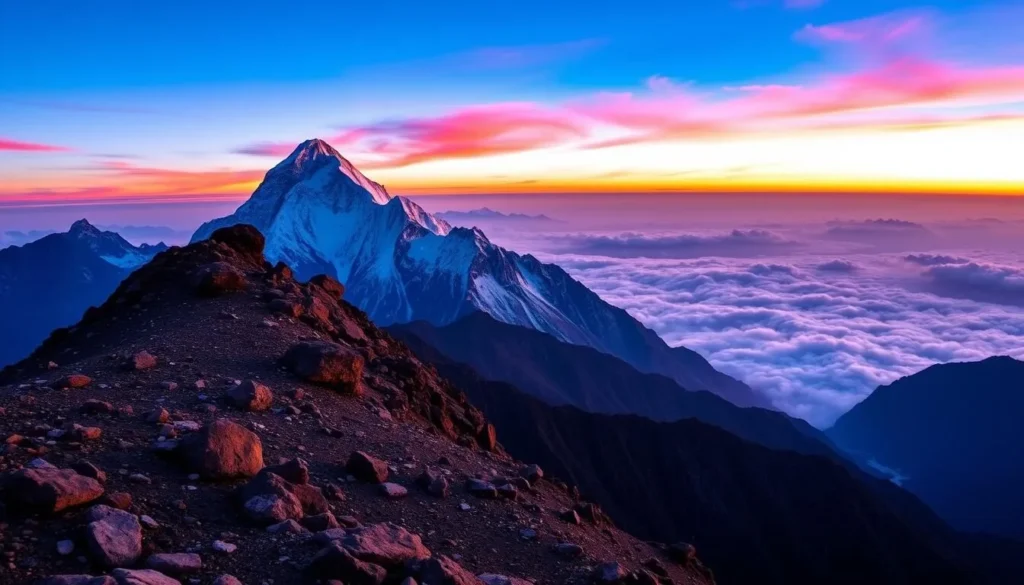
Kala Patthar, a rugged peak above Gorak Shep, offers an unmissable opportunity to witness the majestic sunrise over Everest. At an altitude of 18,208 feet (5,550m), this challenging hike is rewarded with breathtaking views that make it a highlight of the Everest Base Camp trek.
The Challenging Ascent
The hike to Kala Patthar is not for the faint of heart. It involves a steep ascent of 1,640 feet (500 meters) from Gorak Shep, which typically takes about two hours to complete. The climb is demanding, but the promise of witnessing the sunrise over Everest makes it an unforgettable experience. To make the most of this hike, it’s essential to start early, layering up for the extreme cold and bringing headlamps to navigate the dark trails.
Unparalleled Views of Everest
From Kala Patthar, the views of Mount Everest, the Khumbu Icefall, and the surrounding peaks are truly unparalleled. The vantage point offers a clearer view of Everest than Everest Base Camp itself, as the mountain is partially obscured from the base. The sunrise casts a golden glow on Everest’s summit, making it a photographer’s paradise. To capture the best shots, consider using a tripod and adjusting your camera settings for the challenging lighting conditions.
The experience of hiking to Kala Patthar for sunrise views is considered by many to be the defining moment of their Everest Base Camp trek. Despite the physical challenge, the reward is well worth the effort, leaving trekkers with memories that last a lifetime.
Explore the Khumbu Icefall
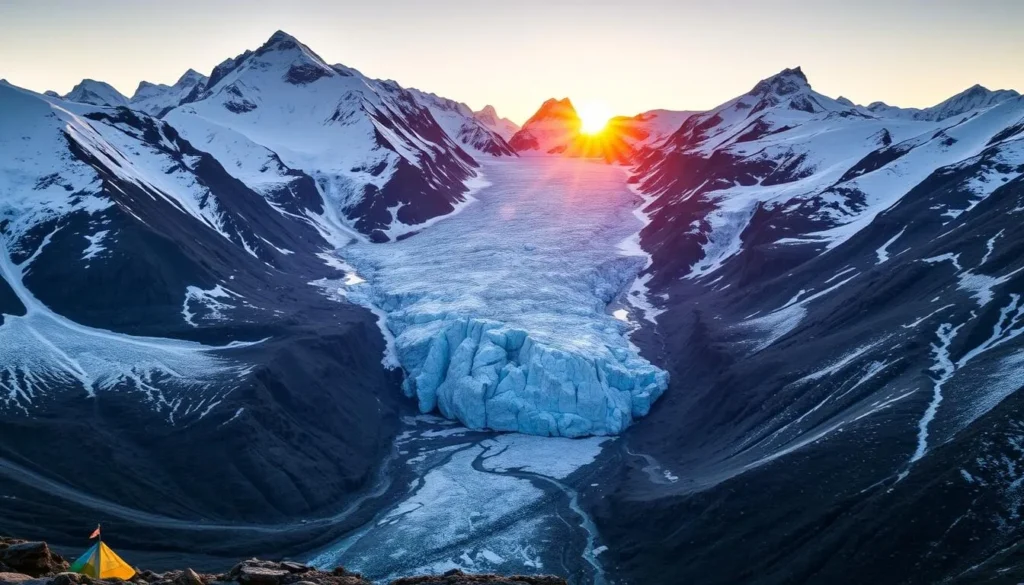
As you stand at Everest Base Camp, the Khumbu Icefall is an awe-inspiring sight that beckons your attention. This natural wonder is not only a breathtaking spectacle but also a critical part of the Mount Everest climbing route.
Geological Marvel
The Khumbu Icefall is a dynamic and rapidly changing glacier that descends from the Western Cwm, creating a maze of towering ice seracs and deep crevasses. As the Khumbu Glacier moves approximately 3-4 feet per day, the icefall is constantly in motion, presenting a unique challenge for climbers on the trail to the summit of Everest.
This geological marvel is a testament to the powerful forces that shape our mountain landscapes. The icefall’s formation is a result of the glacier’s rapid descent, which creates an ever-changing landscape of ice and snow.
Safety Considerations
When viewing the Khumbu Icefall from Everest Base Camp or the surrounding areas, make sure to maintain a safe distance. The icefall is a hazardous environment due to falling ice and crevasses, so it’s crucial to follow guide instructions and stay on designated trails.
For climbers, navigating the Khumbu Icefall requires careful planning and preparation. The use of aluminum ladders and fixed ropes helps to mitigate some of the risks, but climbers must still be cautious as they make their way through this treacherous section of the route to the summit.
To safely observe and photograph this spectacular ice formation, consider visiting vantage points that offer a clear view without putting you at risk. The best times for viewing are typically early morning or late afternoon when the light is favorable.
Everest Base Camp, Nepal: Best Things to Do for Adventure Seekers
At Everest Base Camp, the real adventure begins, offering a mix of adrenaline-pumping activities and cultural experiences. As you stand at the foot of the world’s highest mountain, you’ll be surrounded by the stunning beauty of the Himalayas, creating an unforgettable experience.
![]()
Photography Opportunities
Everest Base Camp is a paradise for photographers. The colorful expedition tents against the backdrop of the Khumbu Icefall and the surrounding peaks offer a perfect shot. You can capture the majestic beauty of the Himalayas during the golden hour, when the mountains are bathed in a warm, golden light. The vibrant prayer flags and stone memorials at Base Camp add to the visual feast, making for compelling photographs.
Tips for Photography: Be prepared for changing weather conditions, and consider bringing a telephoto lens to capture the details of the mountains and the activities of climbers and trekkers.
Meeting Climbers and Expedition Teams
During the spring climbing season, particularly in April, you have the unique opportunity to meet and interact with climbers and expedition teams preparing for their summit attempts. Witnessing the logistics and preparations of major climbing expeditions is an exhilarating experience. You might even get to participate in small ceremonies or celebrations that expedition teams hold before their summit push.
You can also visit the Everest ER medical clinic tent to learn about high-altitude medicine and the challenges faced by climbers. Observing and photographing the prayer flags and stone memorials at Base Camp respectfully adds to the cultural experience. Standing at the foot of the world’s highest mountain gives you a profound sense of accomplishment and adventure.
The experience at Everest Base Camp is not just about reaching a destination; it’s about immersing yourself in the adventure, culture, and natural beauty of the Himalayas.
Immerse in Sherpa Culture and Villages
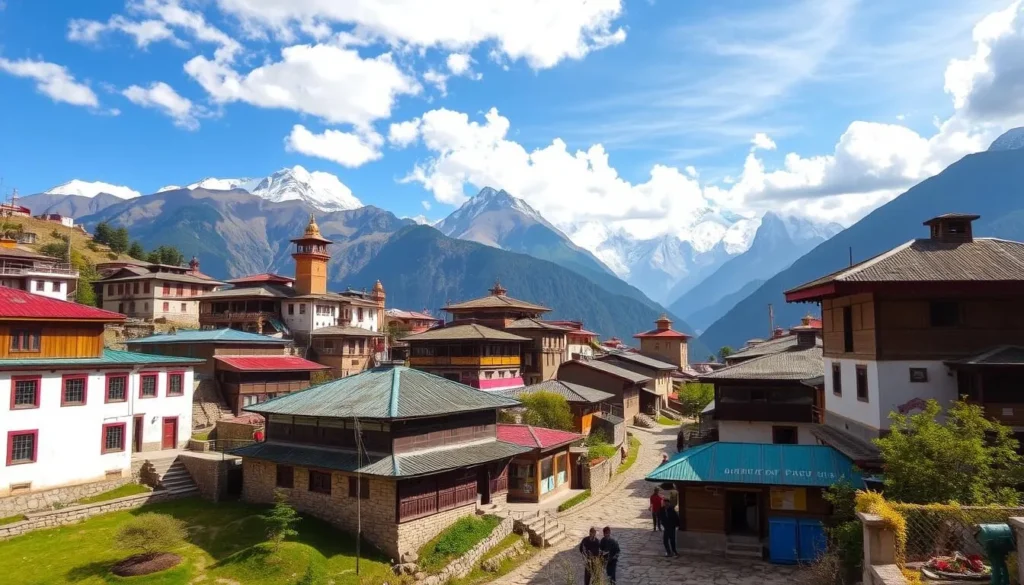
Trekking to Everest Base Camp isn’t just about reaching a destination; it’s about immersing yourself in the vibrant Sherpa culture. As you make your way along the trail, you’ll pass through numerous Sherpa villages, each with its unique charm and character.
Local Customs and Traditions
The Sherpa people have a rich cultural heritage, deeply influenced by Tibetan Buddhism. You’ll notice colorful prayer flags fluttering in the wind and intricate mani stones along the trail. Visiting villages like Phakding, Namche Bazaar, and Khumjung offers a glimpse into the daily life and traditions of the Sherpa people. Be sure to respect local customs, such as removing your shoes before entering monasteries or homes, and participating in cultural activities when invited.
Sherpa festivals, like the Mani Rimdu festival, are an integral part of their cultural identity, showcasing their music, dance, and religious practices. Engaging with the local community and learning about their customs can greatly enrich your trekking experience.
Authentic Food Experiences
One of the highlights of trekking to Everest Base Camp is the opportunity to savor authentic Nepali cuisine. Teahouses along the trail serve traditional dishes like Dal Bhat, a staple meal of rice and lentils, which provides the necessary energy for your trek. You can also try other local specialties such as Tibetan bread, momos (dumplings), and butter tea.
Enjoying these local culinary delights not only satisfies your taste buds but also gives you a deeper appreciation for the Sherpa culture. As you dine in teahouses, you’ll have the chance to interact with other trekkers and locals, sharing stories and experiences that make your journey even more memorable.
Accommodation and Teahouses Along the Trek
As you embark on the Everest Base Camp trek, you’ll find that teahouses are the primary accommodation option along the trail. These simple yet comfortable lodges are designed specifically for trekkers, offering basic rooms and home-cooked meals.
What to Expect in Mountain Lodges
Teahouses provide the essential amenities you need during your trek. Typically, rooms come with twin beds featuring foam mattresses, minimal furnishings, and shared bathrooms. The common areas, particularly the central dining room with a wood stove, become gathering places for trekkers in the evenings, fostering a sense of community among travelers.
The level of comfort in teahouses varies with elevation. At lower altitudes, you can expect more amenities, while higher up, facilities become more basic. Understanding this variation helps in managing your expectations.
| Altitude | Amenities |
|---|---|
| Lower altitudes (below 12,000 ft) | More amenities, including attached bathrooms in some cases |
| Higher altitudes (above 12,000 ft) | Basic facilities, shared bathrooms |
Comfort Tips for Teahouse Stays
To ensure a comfortable stay in teahouses, consider bringing a good sleeping bag and layering clothing for cold nights. Using a sleeping bag liner can also enhance your sleeping experience. Be prepared for the cost of hot showers, which range from $3-5 USD when available. It’s also crucial to use only solar-heated water to protect the environment.
Electricity access can be limited, so plan accordingly for charging your devices. Managing your expectations about comfort while still enjoying the authentic mountain experience is key to a fulfilling trek.
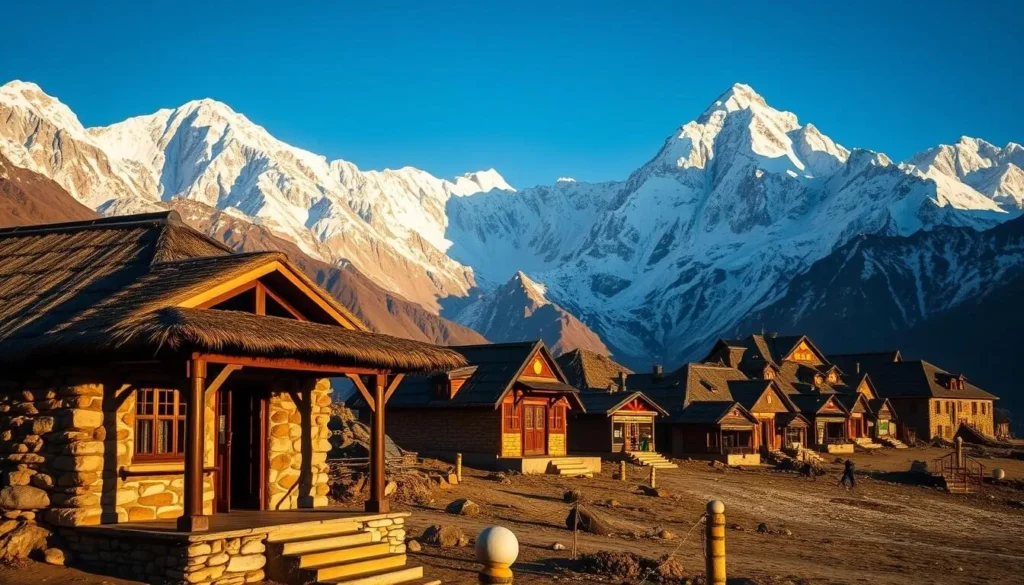
Essential Gear and Equipment for Your Trek
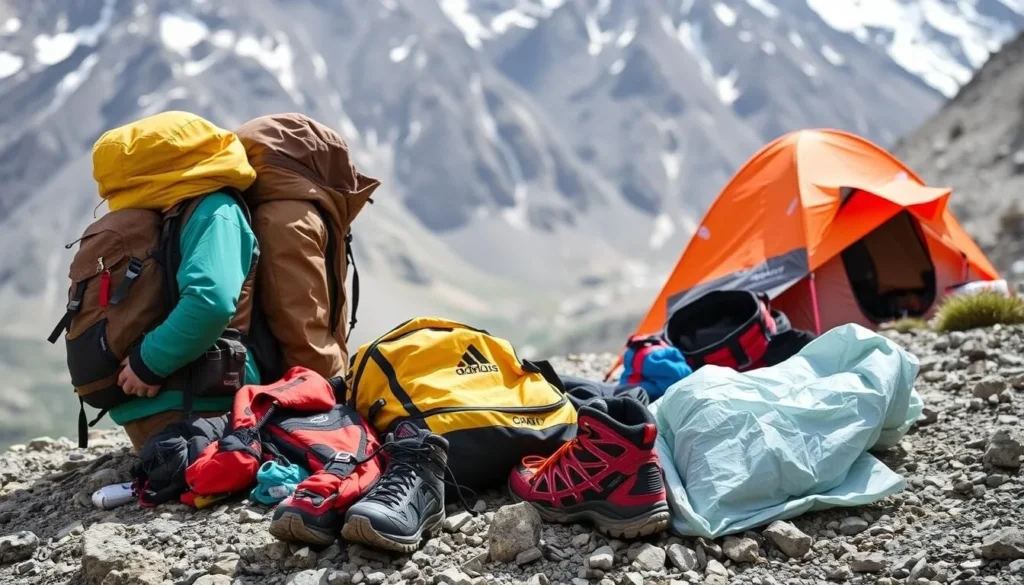
To ensure a comfortable and safe journey to Everest Base Camp, choosing the right equipment is key. The initial flight from Kathmandu to Lukla has strict weight limits, and porters carrying your gear up and back to EBC also have size and weight restrictions. Therefore, it’s crucial to pack thoughtfully.
Clothing and Layering
Proper layering is vital for the variable mountain conditions, where temperatures can fluctuate dramatically between day and night. You should include moisture-wicking base layers, insulating mid-layers, and waterproof outer layers in your packing list. Additionally, well-broken-in waterproof trekking boots with good ankle support are essential for the trek.
When considering what to pack, remember that your main pack should weigh around 22-33 pounds (10-15kg), with a small 30-liter day pack for carrying essentials on the trail.
Trekking Equipment and Accessories
Besides clothing, several key items are necessary for a successful trek. These include a quality sleeping bag rated for low temperatures, trekking poles for stability, a headlamp for navigating in the dark, and water purification methods to ensure safe drinking water. Don’t forget sun protection at high altitude, such as high-SPF sunscreen, sunglasses with UV protection, and a brimmed hat.
Other personal items that can enhance your trekking experience include a good quality camera, a portable charger, and minimal toiletries, all of which should be packed thoughtfully to keep your overall weight down.
Health and Safety at High Altitude
Trekking to Everest Base Camp is a thrilling experience, but it’s essential to prioritize your health and safety as you ascend to high altitudes. The Everest Base Camp trek reaches elevations where altitude sickness can be a significant risk.
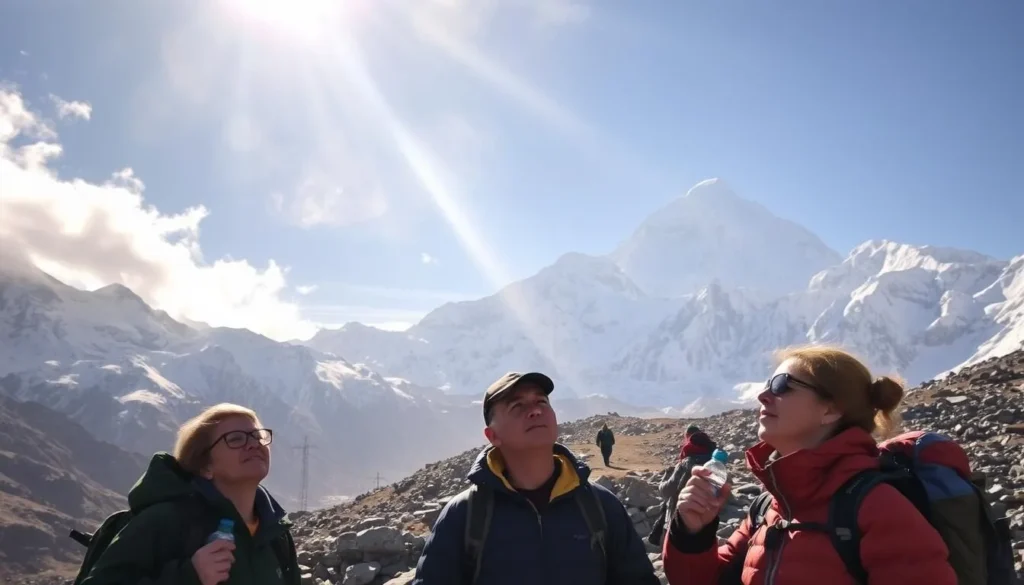
Acclimatization Strategies
Proper acclimatization is key to a safe and successful trek. The “climb high, sleep low” strategy is employed on designated rest days in Namche Bazaar and Dingboche. This involves climbing to a higher altitude during the day and then descending to a lower altitude to sleep, helping your body adapt to the higher elevations. Make sure to include these rest days in your itinerary to avoid altitude sickness.
It’s also crucial to stay hydrated by drinking 4-5 liters of water daily. Dehydration can exacerbate altitude sickness, so make sure to drink plenty of water throughout the day.
Dealing with Altitude Sickness
Acute Mountain Sickness (AMS) is a risk on the Everest Base Camp trek. Symptoms include headaches, nausea, and fatigue. If you experience any of these symptoms, it’s essential to rest and hydrate. In severe cases, descent to a lower altitude is necessary. Medications like Diamox can help prevent and treat AMS, but consult a doctor before using them.
Maintaining hygiene on the trail is also vital to prevent illness. Use water purification tablets or hand sanitizer to keep yourself safe. In case of serious altitude-related illnesses, emergency procedures are in place, including the availability of oxygen and evacuation options.
Practical Tips for an Unforgettable Everest Experience
With the right preparation and knowledge, your Everest Base Camp adventure can be a truly life-changing experience. As you embark on this journey, it’s crucial to be aware of the practical aspects that can make or break your trip.
Communication and Connectivity
Staying connected during your trek is vital, especially in case of emergencies. Wi-Fi is available in teahouses along the trail, although it may come at a fee. Mobile phone coverage is also present in certain areas, with NCell generally offering better coverage than Nepal Telecom, particularly at higher elevations.
For a reliable internet connection, consider purchasing an Everest Link hotspot card, available in 10GB and 20GB packages. In case of a medical emergency, having a satellite communications device is indispensable. Make sure your team is equipped with this device to call for emergency evacuation services directly.
| Service Provider | Coverage at Higher Elevations | Reliability |
|---|---|---|
| NCell | Good | High |
| Nepal Telecom | Poor | Medium |
Responsible Trekking Practices
As you trek through the Everest region, it’s essential to adopt responsible trekking practices to minimize your impact on the environment. Proper waste disposal, minimizing plastic use, and respecting local customs are crucial. Bringing extra cash for additional expenses like Wi-Fi, hot showers, and tipping guides and porters is also recommended.
Tipping guidelines suggest approximately $20-30 per client per week for guides and $4-7 per group per day for porters. Moreover, having travel insurance that covers high-altitude trekking and helicopter evacuation, with a minimum coverage of $200,000, is highly advisable.
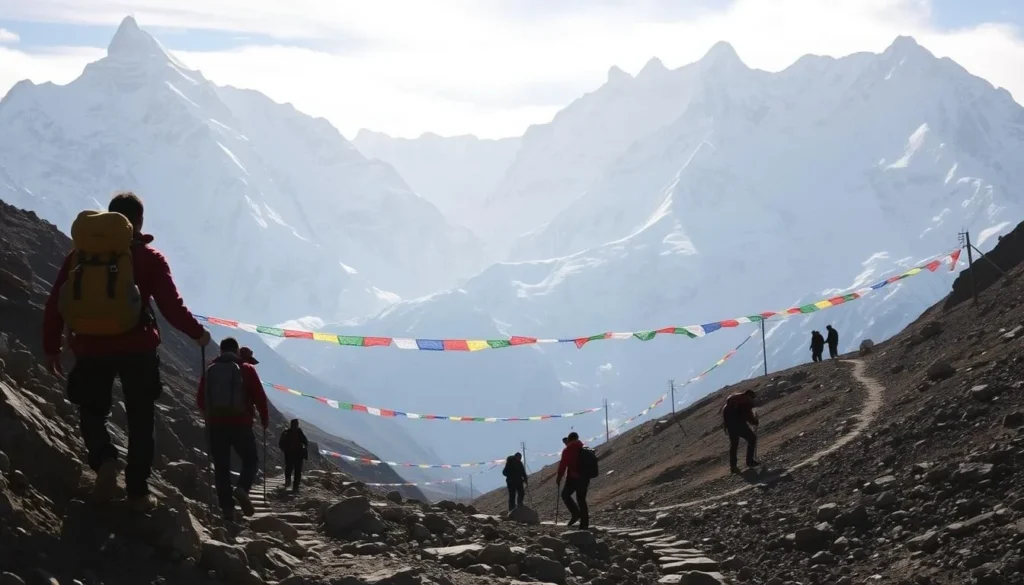
Conclusion: The Life-Changing Journey to Everest Base Camp
The journey to Everest Base Camp is a once-in-a-lifetime adventure that seamlessly blends physical challenge, cultural immersion, and awe-inspiring landscapes. As you trek to Everest Base Camp, you’ll experience a transformative journey that pushes your limits and broadens your perspective.
From the thrilling flight to Lukla to the stunning vistas of the Khumbu Icefall, every step of the way is a testament to the region’s natural beauty and rich cultural heritage. Along the trail, you’ll pass through picturesque Sherpa villages, visit the revered Tengboche Monastery, and witness the breathtaking sunrise from Kala Patthar.
The sense of achievement that comes from completing this challenging trek and standing at 17,598 feet (5,364m) at Everest Base Camp is unparalleled. However, the true value of the experience lies not just in reaching Base Camp but in the entire journey – the people you meet, the challenges you overcome, and the perspectives you gain along the way.
As you prepare for this iconic journey, remember to pack essential gear, respect the local environment and culture, and take time to appreciate the breathtaking views around you. With proper preparation and an open mind, your trip to Everest Base Camp will be an unforgettable adventure that leaves you with lifelong memories and a newfound appreciation for the world’s highest peak.
The above is subject to change.
Check back often to TRAVEL.COM for the latest travel tips and deals.
